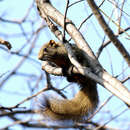en
names in breadcrumbs


Perception Channels: tactile ; chemical
There is no threat to this species as they have been widely introduced from their ancestral home ranges to new localities such as Tomogashima Island. Numbers there have increased profoundly and these squirrels had colonized the whole island by 1959, only 5 years after being first introduced.
IUCN Red List of Threatened Species: least concern
The small negative effects of red-bellied squirrels lies primarily in their habit of gnawing on tree bark, sometimes killing the tree. Also their consumption of oil palm nuts has brought them into conflict with plantation owners who now hunt them as pests. (NatZoo 1992)
Negative Impacts: crop pest
Red-bellied squirrels are valuable for their ecosystem roles, particularly as seed dispersers.
Red-bellied squirrels are important as seed dispersers of tree species.
Ecosystem Impact: disperses seeds
Similar to all tree squirrels, red-bellied squirrels rely heavily on a diet consisting of leaves, fruit, seeds, insects, nuts, acorns, and cones. These squirrels feed mainly in the trees, but do spend some time feeding on the surface. Clearly they rely most heavily on arboreal foods and procure most foodstuffs while keeping their place among the branches. Red-bellied squirrels are well adapted in that they rotate their dietary consumption based on the seasonal availability of the item. In winter, they consume primarily Camellia tree flowers, which bloom from October to June. Later the diet switches toward the greatest period of leaf consumption from April to May. In June their palate is suffused with the luscious fruits that are now abundant. And as fall comes around, red-bellied squirrels busy their jaws with the nutritiously profitable food source of ants that are still active above ground as opposed to the usual hoarding behavior. (Setoguchi 1990)
Animal Foods: insects
Plant Foods: leaves; seeds, grains, and nuts; fruit
Foraging Behavior: stores or caches food
Primary Diet: herbivore (Frugivore , Granivore )
Red-bellied squirrels naturally inhabit southern China, Malaya, and the lowlands and mountains of Taiwan. In 1935, 40 individuals were removed from Taiwan and introduced on the island of Izuoshima, about 100 km south of Tokyo, Japan. Later, 100 squirrels were taken from the Izuoshima population and moved 400 km west to Tomogashima Island. (Setoguchi 1990)
Biogeographic Regions: oriental (Introduced , Native )
The habitat has a mean temperature of 15.8 degrees Celsius and mean rainfall of 1,455 mm. Vegetation consists of warm-temperate evergreen trees and woody plants with a high occurrence of fruiting vegetation such as the camellia and bayberry.
Habitat Regions: temperate ; terrestrial
Terrestrial Biomes: forest ; rainforest
Average lifespan
Status: captivity: 16.1 years.
Callosciurus erythraeus are medium in size with adults reaching a total head and body length of up to 200 mm. They have strong claws on their fingers and toes, excellent for digging holes to cache a supply of nuts. The ankles have extreme rotational capability and the claws, which they sink into the bark of a tree branch or trunk as they run, ensure them a firm grip as they chase nimbly through the trees. With large, protruding eyes, red-bellied squirrels have sharp vision and can distinguish vertical objects particularly well -- a useful ability for an animal that spends much of its time in trees leaping from branch to branch. Because of eye location, they are able to see behind, overhead and underneath without turning their heads, giving them the ability to survey the area for any signs of danger. The eyes also contain cones within the retina, allowing Callosciurus erythraeus to see the bright colors of its surroundings. (NatZoo 1992)
Other Physical Features: endothermic ; homoiothermic; bilateral symmetry
Sexual Dimorphism: sexes alike
Average mass: 272 g.
Red-bellied squirrels are sexually promiscuous. On the female's day of estrus, several males gather around her and begin vocalizing. These vocalizations are the beginning of mating bouts in which the males spar with one another to win the right to mate. The winner of the bout will often guard his mate for a short period of time, trying to ensure that he is the true fertilizer of the female's eggs. But if the number of challenging males gets to be too much, the "guard" usually leaves and she may mate (and usually does) with another individual.
Mating System: polygynandrous (promiscuous)
The female first scouts and then builds a nest in a suitable and relatively protected site. This behavior peaks in spring and autumn in accordance with the breeding seasons. In that nest, the female gives birth usually to several young.
(Setoguchi 1991)
Key Reproductive Features: iteroparous ; seasonal breeding ; gonochoric/gonochoristic/dioecious (sexes separate); sexual ; fertilization (Internal ); oviparous
Young are cared for and nursed by females in the nest until they reach independence.
Parental Investment: altricial ; female parental care